Sudden stratospheric warming and stretched polar vortex may not have caused frigid temps
NATIONAL CENTER FOR ATMOSPHERIC RESEARCH/UNIVERSITY CORPORATION FOR ATMOSPHERIC RESEARCH
A new study challenges a commonly accepted explanation that a “sudden stratospheric warming” caused the unusually cold weather over the U.S. early last year, a view which was widely reported in the media and discussed among scientists at the time.
Instead, the research finds that the spike in temperature of the normally frigid air mass locked high above the Arctic on Jan. 5, 2021 — and the accompanying disruption of the polar vortex — did not significantly impact weather in the weeks that followed, including the unprecedented and brutal cold snap that gripped Texas that February.
The research findings are valuable for scientists who are working to extend weather forecasts beyond today’s two-week window and who are increasingly focused on events in the stratosphere as possible sources of longer-term predictability. Sudden stratospheric warmings, for example, occur on average every other year during winter, and in the month that follows, a predictable pattern of weather tends to unfold, including cold air outbreaks in the United States. However, the mechanism that might connect the events is not well understood.
For the new study, published last week in the journal Nature Communications, a team of scientists led by the National Center for Atmospheric Research (NCAR) used a sophisticated Earth system model to analyze the sudden stratospheric warming that occurred on Jan. 5, 2021 and its potential impacts. Using a new method to assess causality, they found that while the subsequent weather did indeed match the expected pattern, the sudden stratospheric warming itself was not likely the cause.
“The mechanisms for how these layers of the atmosphere interact are probably more nuanced than we’re giving them credit for, and that’s important for making better forecast models,” said NCAR scientist Nicholas Davis, who led the study. “Once you know the mechanism, you can model it better.”
The research was funded by the National Science Foundation, which is NCAR’s sponsor, the U.S. Department of Energy, and NOAA.
“Scrambling” the forecast
During the Northern Hemisphere winter, when the North Pole tilts away from the Sun and remains shrouded in darkness, a frigid mass of cold air forms in the stratosphere above the pole. The cold air is locked into place by a jet stream called the stratospheric polar vortex.
Occasionally, the polar vortex is disrupted by planetary-scale waves, which propagate upward from the troposphere, the lowest layer of the atmosphere. When these planetary-scale waves break, they warm the vortex, which can weaken it and cause it to be displaced or split in two — an event known as a sudden stratospheric warming. In the month afterward, it’s usually warmer than normal in Canada, Alaska, and the Middle East and colder than normal over Siberia, with more frequent cold air outbreaks in Europe and the United States.
For the new study, the researchers dug into the connections between the stratosphere and troposphere using the NCAR-based Community Earth System Model version 2 (CESM2) configured with an atmospheric component called the Whole Atmosphere Community Climate Model (WACCM).
To start, the team kicked off the model using the atmospheric conditions present in both the stratosphere and the troposphere on Jan. 4, 2021, the day before the sudden stratospheric warming took place. This “standard forecast” did an excellent job of capturing the weather that actually occurred over the following four weeks.
Then the team ran three more forecasts. In one forecast, the troposphere was “scrambled,” meaning the conditions in the troposphere did not match the actual weather observations from Jan. 4, 2021. In a second forecast, the stratosphere was scrambled, which removed the sudden stratospheric warming from the forecast.
The scrambling experiments showed that the initial state of the stratosphere had no impact on the weather in the two weeks after the sudden stratospheric warming, and only a minor impact nearly one month later, when the stratosphere acted to sustain the expected weather patterns. Instead, the initial state of the troposphere was the primary driver.
“I think everyone imagined that a pinball is shot up from the troposphere, hits the polar vortex, and breaks it apart,” Davis said. “And then another pinball shoots back down and changes the weather. But this study shows that it’s not so simple. I think it possible that the events in the troposphere and the stratosphere are feeding back on one another and reinforcing what’s happening.”
The Texas deep freeze
The research team also analyzed the record-breaking cold temperatures that swept across Texas and the central U.S. in mid-February 2021. Because the cold snap happened about six weeks after the sudden stratospheric warming, it was beyond the timeframe of predictability associated with that event. However, the polar vortex had not yet recovered from the sudden stratospheric warming and remained stretched, looping down over North America, a configuration often associated with cold air outbreaks in the U.S.
Scientists have posited that a disturbed polar vortex can reflect planetary waves back down into the troposphere where they can intensify weather systems and create cold air outbreaks in the United States, but whether this mechanism is at work is unclear.
The research team ran a series of simulations, as before, but this time they kicked them off using atmospheric conditions on Feb. 8, 2021, about a week prior to the onset of the extreme cold. In this case, the team found that the standard forecast did a good job of predicting the vortex stretching, the wave reflection, and the extreme cold conditions over North America. The forecast with the scrambled stratosphere, on the other hand, did not capture the wave reflection nor the full extent of the polar vortex stretching, but its temperature forecast was about the same as the standard forecast, suggesting that the vortex stretching and wave reflection did not contribute to the cold air breakout.
A better forecast
The same atmospheric elements that cause a sudden stratospheric warming — and associated distortion in the polar vortex — may also be causing the weather patterns, though the sudden stratospheric warming may be helping to sustain them over long periods. And because the emergence of a sudden stratospheric warming is predictable weeks in advance, the weather pattern that follows also remains more predictable.
The new research, however, could allow for more accurate predictions in the future, since an improved understanding of the actual mechanisms connecting the two phenomena could improve the forecast models themselves. A better understanding of the mechanisms at play could also help scientists evaluate how the changing climate could amplify or dampen the connections between the troposphere and the stratosphere.
The study is also valuable because of the “scrambling” technique it demonstrates, Davis said. This technique allows the “scrambled” component of the model to drift for a week leading up to the date that the actual forecast is started on, while the “unscrambled” components are nudged to align with observations during the same time. This new ability to experimentally separate out resolved components of the Earth system, while also keeping the whole system physically consistent, could allow scientists to undertake an array of attribution studies to look at causal relationships in the atmosphere and larger Earth system.
“This forecast model set-up and approach will allow us to answer some urgent questions about attribution — what is really the underlying cause of weather and climate events — in nearly real time,” Davis said. “If we have a hypothesis about what the mechanism for an event is, this technique can provide us with a more direct answer.”
This material is based upon work supported by the National Center for Atmospheric Research, a major facility sponsored by the National Science Foundation and managed by the University Corporation for Atmospheric Research. Any opinions, findings and conclusions or recommendations expressed in this material do not necessarily reflect the views of the National Science Foundation.
About the article:
Title: Limited surface impacts of the January 2021 sudden stratospheric warming
Authors: N. A. Davis, J. H. Richter, A. A. Glanville, J. Edwards, and E. LaJoie
Journal: Nature Communications
JOURNAL
Nature Communications
DOI
METHOD OF RESEARCH
Computational simulation/modeling
ARTICLE TITLE
Limited surface impacts of the January 2021 sudden stratospheric warming
ARTICLE PUBLICATION DATE
3-Mar-2022
Polar vortex was disrupted by Kamchatka volcano eruption in late December. Plume of hot air was blown to polar region by polar jet stream blowing anti-clockwise.
“Tue, 22 Dec 2020
Sheveluch volcano (Kamchatka, Russia): powerful eruptionA few hours later, at 19:30 local time on today evening, another strong explosion detected by Volcanic Ash Advisory Center (VAAC) Tokyo produced spectacular ash plume rising up to 28,000 ft (8,500 m) altitude and extended about 130 km to the southeast of the volcano. Incandescence continues to be observed in the crater identified in satellite data.”
Then explain the more powerful disruption the previous winter that put the energy grid in Texas on its knees.
“Sheveluch volcano Tue, 22 Dec 2020″ mentioned above caused Jan-Feb 2021 severe winter weather in the USA (including Texas freeze) and NW Europe.
NCAR archives may still have the polar vortex data and images for early 2021.
The above images are from the 2009 winter which was just as sever (see vukcevic.co.uk/NH.htm or search the web) when I formulated the above hypothesis.
On January 18, 2021 6:10 am I wrote on WUWT
What are the Implications?Very cold February in the North hemisphere.
The above is straight copy & paste what I wrote then
https://wattsupwiththat.com/2021/01/18/the-stratosphere-has-warmed-profoundly-this-month-what-are-the-implications/#comment-3164797
Vuk, are you saying that this eruption is what heated the polar stratosphere? NCAR simply takes it as an unknown given that every few years the the polar strata heats up.
Your graphics are very convincing. This is worthy of a paper. You can fill in the blank that NCAR doesnt have an answer for.
Cheers, Gary
.
Thanks Gary
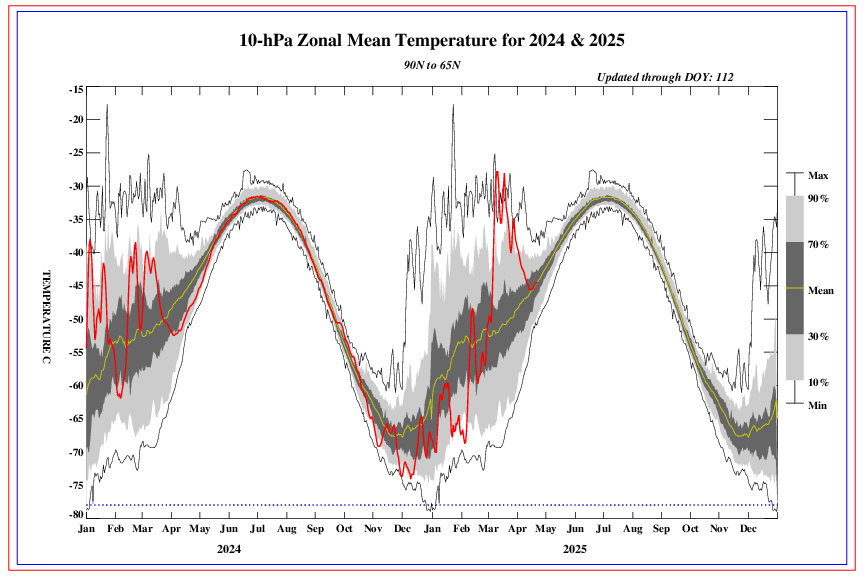
That would have to be confirmed by actual measurement data.
I could speculate that a dome of warm troposphere is rising upwards into the stratosphere’s altitudes.
Whether that would be stratosphere or upward expanded part of troposphere, I suspect it would depend if there is a detectable physical delineation between the two.
As I recall 10 hPa is somewhere around 8.5km, just at the altitude that Sheveluch ash plume rose (28,000 ft or 8,500 m altitude)
The 2020/21 winter SSW was about 30C (-65 to -35 C) see above graph
Just as Peta below points out, the air is so thin in the strato vortex that it is easily disrupted by a denser rising mass. With rock particles in the volc plume and entrained hot gases, it is a decent hypothesis. Perhaps if Sheveluch erupts strongly again, validation could be a correct forecast for freezing in Texas!
I was studying winter polar vortex split of winter 2009 in relation to NH magnetic field distribution
http://www.vukcevic.co.uk/NH.gif
then in 2011 wrote a short ‘paper’ demonstrating the SSW links to the Kamchatka volcanoes on suggestion of Dr. J Curry.
https://hal.archives-ouvertes.fr/file/index/docid/563477/filename/SSW.pdf
2013 winter confirmed my hypothesis, this time it was Tolbachik volcano erupting in late December 2012 causing SSW and severe USA winter
http://www.cpc.ncep.noaa.gov/products/stratosphere/temperature/archive/30mb9065_2013.gif
2021 winter was yet another validation.
Looks like it’s happening again – bundle up! Polar vortex dips south later this week. More “global warming…”
Told you so, 20 years ago.
JAN-LIKE COLD TARGETS U.S.; NEW STUDY QUESTIONS EXPLANATION FOR FEB 2021’S RECORD FREEZE; + UKRAINE HALTS ALL EXPORTS, CLEARS FARM WORKERS FROM MILITARY SERVICEMarch 8, 2022 Cap Allon
As is all too often the case when digging into a widely held scientific assumption, it turns out that its foundations are incredibly weak…
ANOMALOUSLY FRIGID FEBS FOR AUSTRALIA, JAPAN, SOUTH KOREA AND HONG KONG; SARDINIA SUFFERS LOWEST MARCH TEMPERATURE EVER; HEAVY SNOW BLANKETS TURKEY, DELAYING SPRING; + WINTER WILL HAVE “FINAL, PUNISHING ACT” FOR LOWER-48
March 4, 2022 Cap Allon
Despite the AGW Party willing Earth’s mercury up, it isn’t listening — the global average temperature is down 0.71C from its 2016 peak, and falling…
Absolutely Vuk.
The vortex is also ‘upset’ by the remnants of large storms coming northwards eastwards and running ashore up the PNW coast.
Those things ‘bounce’ upwards off the The Rockies and if they still have significant energy within them, behave exactly as the volcano did.
i.e They inject a big lump of warm air into the place where the Stratosphere meets the Troposphere = where the Jet Stream flows
The Jet Stream being = the lowest latitude and lowest altitude manifestation of The Polar Vortex
Despite being very big and moving at very high speed. the vortex actually contains very low amounts of energy, hence why it’s cold. It moves with laminar flow = it has very low turbulence/mixing – hence the high speed.
But all those things mean that it is very ‘fragile’ – it breaks easily.
And that is what volcanoes and old pacific storms do, they inject energy (= the observed sudden warming) and the vortex repays the favour by becoming turbulent.
It breaks and bits fly off.
Always to lower altitude and always in a South Easterly direction (for the northern hemisphere anyway)
After that, anything can happen anywhere BUT, if you live in a desert, those ‘happenings’ can be rather extreme.
As Texas found out.
No thermal inertia you see. Nothing in the ground to keep you warm – why you might take a ‘hot water bottle‘ to bed with you
I suggest we/you/all of us do something about fixing the desert – lets *try* to get Cause & Effect the right way round because if we don’t, we really are finished
Peta, I just raved about Vuk’s volcanic mechanism. Yours is also convincing! It makes good sense that the very thin strat is easily disrupted. If you can garner the data as Vuk has, you guys could write a paper, supplying the heating and disruption that NCAR takes as a periodic given.
Wow I’m having a good science day!
The researchers would see both these effects if they would take their noses out of their models. Interesting that the article didn’t mention global warming, climate change, etc.
No money for “terraforming” the US deserts by increasing the organic mass in the soil, since the current P. T. Barnum plan is, to terraform Mars.
Besides, who would shoot at an empty desert and we might soon need the wild out- yonder for a safe space.from the nuclear wastelands, which the current crew pulling all the strings, seems determined to create.
The true believers argue that we must save the planet by depopulating us, n’est pas?
Vuk,
You hit the nail on the head.
The linking of the polar vortex split caused by the change in stratophere is so obvious now that you explained it so well.
I have been studying the linking of the solar wind with changes in the atmosphere. It all fits together along with earthquakes too.
Thanks
Method of Research: Computational simulation/modeling.
Straight away it’s doomed to fail even if they did use “a sophisticated Earth system model”
“Once you know the mechanism, you can model it better.”
“However, the mechanism that might connect the events is not well understood.”
So they can’t really model it, but….
“The study is also valuable because of the “scrambling” technique it demonstrates, Davis said. This technique allows the “scrambled” component of the model to drift for a week leading up to the date that the actual forecast is started on, while the “unscrambled” components are nudged to align with observations…
A whole lot more tweaking and tuning.
Yep, and I’m happy for them to try to improve short term forecasts, how the hell else are they going to do it other than model?
Seriously, the faith that lots of commentors have in that every model is bad is pretty similar to the faith that warmistas have that CO2 controls everything.
As soon as you see model it triggers this response…..
Well the warmist started it…I mean creating bad models 😉
“every model is bad “
I never said every model. That would imply other fields are just as bad as climate science.
99% of climate models are expensive junk.
The jibe is still somewhat misplaced, as this is not a climate model. It’s a medium term weather model (apparently six to eight weeks).
The way to tell the difference is whether the model is going to be proven viable/unviable very soon (in this case, as soon as this next NH winter, or perhaps two NH winters) – or not proven viable/unviable until the modeler’s pension is fully vested at the very least.
It is at least legitimate work; it may also be good work.
It’s not just us, it’s famous statisticians, too!
https://www.lacan.upc.edu/admoreWeb/2018/05/all-models-are-wrong-but-some-are-useful-george-e-p-box/
I dunno, I once went out with a lovely lassie who left me to become a model.
Running a model is not running an experiment. Using models can be useful but only running models is a trigger here.
Running models and testing them against empirical measurements (and also admitting when the models are not good).
WACCM , Danno !
It’s certainly an interesting study, and the “scrambled” variations are an excellent idea. However –
– it’s only a model. There is a serious possible problem which they may or may not have taken into account, as follows: The models have a vast number of parameters which are used to try to match observations up to the present – far more than are needed to wiggle an elephant’s trunk (https://quotefancy.com/quote/1342664/John-von-Neumann-With-four-parameters-I-can-fit-an-elephant-and-with-five-I-can-make-him). Consequently, the models can get quite a good fit to observation even if they are actually missing some of the real physical factors involved. Thus, for example, it is possible that they can get a good match using troposphere-oriented parameters even though the stratosphere is actually playing an important role. Then, when they get a matching result, they can “scramble” the stratosphere-oriented parameters and the result will still be good. The effect could still be in operation a fortnight later.
In other words, their good result with “scrambled” stratosphere could be because their stratosphere-oriented parameters are ineffective, and not as they claim that in the real world the stratosphere did not cause the cold snap.
I’m not saying this is the case, just that they appear not to have eliminated it as a possibility.
Yes I agree, This problem is particularly true if you tune the parameters of the model, mostly with troposphere data, like I suspect most climate models are.
…so what is the explanation now? The spring break kick-off here is supposed to be a near wintery mix. On the gulf coast.
Yesterday in NJ we hit 70F. Today we were lucky to see 43F. The 10-day forecast says we won’t see 65F again until St Paddy’s day.
We won’t mention the Grand Solar Minimum, will we?
There is no grand solar minimum now nor in the foreseeable future. Today the 30y SN is about 2x that of a GSM designation.
“This forecast model set-up and approach will allow us to answer some urgent questions about attribution — what is really the underlying cause of weather and climate events”
It cannot answer anything about how solar variability caused the cold in January.
Could it be that the earth is simply cooling a bit?
Wow and double Wow, that naughty word KLIMATE is only mentioned once that I could see, and not a mention of “Send us the money for further studies” Hve I missed something?
In short “ our models are inadequate”.
A 2-week window for weather forecasting? Really? More like a 2-day window for weather forecasts in the UK!
” explanation for last winter’s brutal U.S. cold snap ”
Didn’t you see the explanation on the blackboard? Right after “Climate warming was twice as fast” there is that tiny box saying: “Then a miracle occured”.
Out of the mouths of babes:
“Once you know the mechanism, you can model it better.”
The complement of that statement is also true.
We do NOT yet understand the earth’s chaotic weather system so attempts to “model” that system decades in the future are futile.
“… the unusually cold weather over the U.S. early last year, a view which was widely reported in the media and discussed among scientists at the time.“
______________________________________________________________
What cold snap? There’s a reason that during the ’70s scientists and the media reported and discussed “Global Cooling” it was damn cold. People born before 1950 remember it. Last winter is remembered because of the energy infrastructure failure in Texas. Winter storms aren’t necessarily all that cold.
It was is and continues to be called winter and it can be very cold or very mild depending on where you live.
Oh so much weather.
As for climate, 3 years of solar minimum plus La Nina meant that the global atmosphere had a low water vapor content. Low water vapor means that the weather is subject to temperature extremes.
We don’t need a model to come to such conclusions.
In the NH we have a cold air source to the north and warm air source to the south. There is no criterion for stability in a gravitational field, so the air masses involved attempt to exchange places — cold air toward the surface and south/warm air lofted and to the north. While doing so on a rotating planet the north/south flowing air is deflected east/west respectively. The vector connecting surface to upper flows is the “thermal” wind. The thermal wind provides a stabilizing force for the density gradient, but it is not dynamically stable against finite disturbances. Thus, the whole system will produce rossby waves, and oscillates to some degree between zonal and meridional flows.
We have known about the zonal index cycle since after WWII. It is not new or unusual. As far as forecasting goes, I have no opinion or knowledge about methods at present.
A lot of words to say we do not know. Personally, given that the stratosphere has almost no mass I do not see how it can cause an enormous mass of arctic cold air to go down to Texas.
Just like that.

https://www.cpc.ncep.noaa.gov/products/stratosphere/strat_int/
The wave of ozone that falls from the stratosphere pushes moist air outward, and very dry and cold air (the temperature is lowest in the tropopause) sinks to the surface.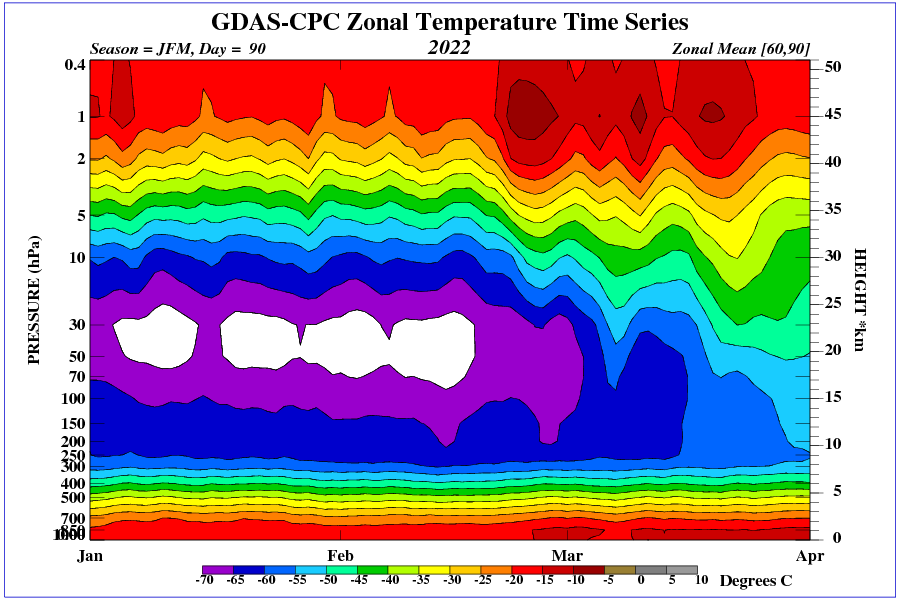
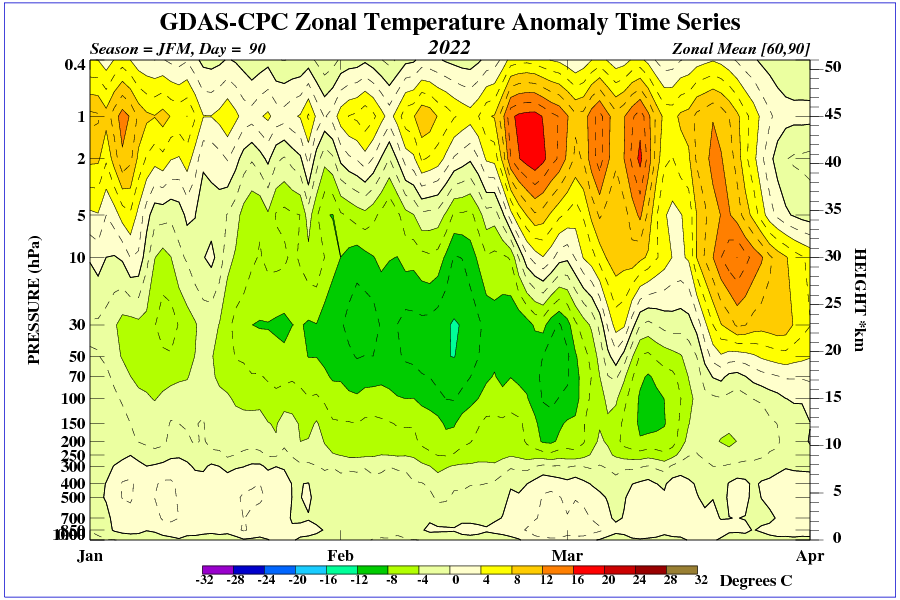
create a low pressure space, higher pressure spaces will flow into it
The distribution of heat over the continents during the winter season is via the oceans. Therefore, long-term changes in atmospheric circulation due to changes in stratospheric circulation (changes in the ozone zone at high latitudes due to solar wind variability) cause changes in winter temperatures over the continents. Therefore, during periods of decreasing UV radiation in weak solar cycles, climate changes will occur in many regions.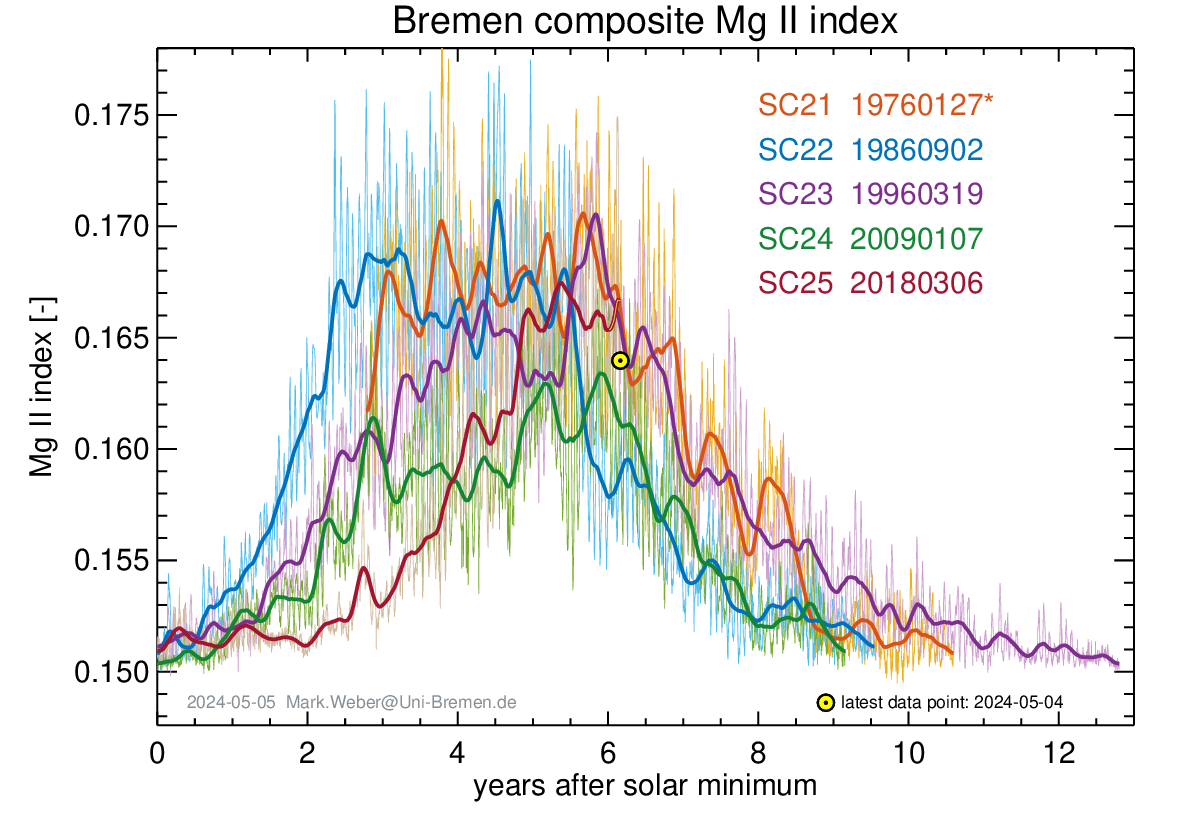

At 70 hPa you can see even better what is currently happening in the lower stratosphere. The SSW resulted in a disruption of the polar vortex, despite very low temperatures in the lower stratosphere.
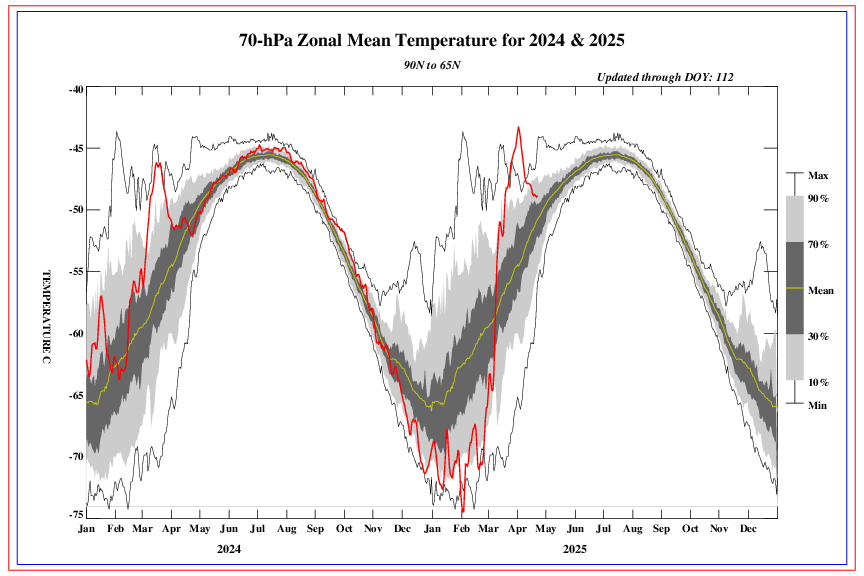
The low temperature is important because the temperature difference in high and mid latitudes drives the polar vortex.
During periods of weaker solar wind magnetic field, the Earth’s magnetic field has a greater influence on the circulation in the stratosphere, which is unfavorable for North America.
I think the real problem is apparent in that picture of Chicago at the top. Too much CO2 in the atmosphere is causing all that dry ice to form.
Seems bad
So here we have one model informing a second model and we are expected to believe the result. Now while the result may well be in line with what many have intuitively known, and/or posited based on normally expected patterns, I just despair at the confidence that the modelling fraternity seem to hang on their results. Sigh….
Regarding “the unprecedented and brutal cold snap that gripped Texas that February”: It is not unprecedented. Cold weather that severe happened there in December 1989, and even worse cold happened there in February 1895.
December ’89 Around Christmas iirc, was a pretty cold one as well
This is what stratospheric intrusion over North America looks like now. Low heights of the 2 potential vorticity unit (PVU) shows the extent of air from the north that does not mix with the surrounding air.
Severe frost in Colorado and northern Texas. Snowstorm in Kansans.